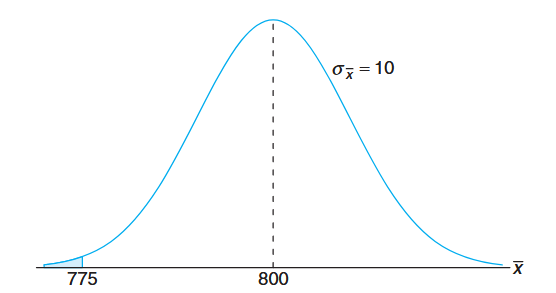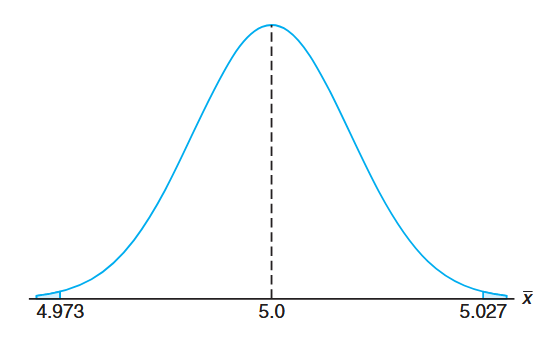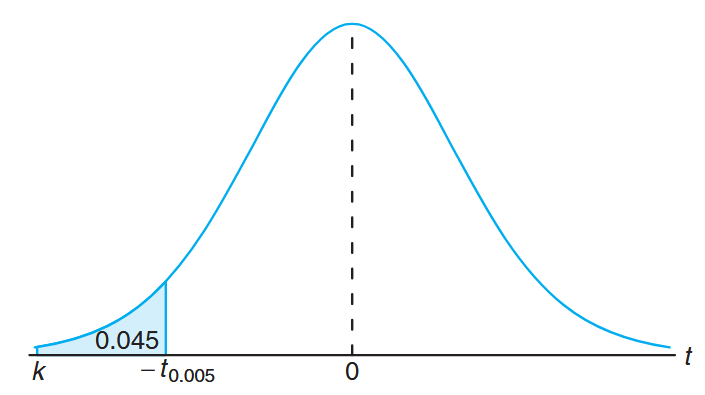Random Sampling
The outcome of a statistical experiment may be recorded either as a numerical value or as a descriptive representation. For example, when a pair of dice is tossed and the total is the outcome of interest, we record a numerical value. However, if the students of a certain school are given blood tests and the type of blood is of interest, then a descriptive representation might be more useful. A person’s blood can be classified in 8 ways:
In this chapter, we focus on sampling from distributions or populations and study such important quantities as the sample mean and sample variance, which will be of vital importance in future chapters. In addition, we introduce the role that the sample mean and variance will play in statistical inference. The use of modern high-speed computers allows the scientist or engineer to greatly enhance their use of formal statistical inference with graphical techniques. Much of the time, formal inference appears quite dry and perhaps even abstract to the practitioner or to the manager who wishes to let statistical analysis be a guide to decision-making.
Populations and Samples
We begin by discussing the notions of populations and samples. Both are mentioned in a broad fashion in the introductory chapter, but more detail is needed here, particularly in the context of random variables.
Definition:
A population consists of the totality of the observations with which we are concerned. The number of observations in the population is called the size of the population.
Examples:
- The numbers on the cards in a deck, the heights of residents in a certain city, and the lengths of fish in a particular lake are examples of populations with finite size.
- The observations obtained by measuring the atmospheric pressure every day, from the past on into the future, or all measurements of the depth of a lake, from any conceivable position, are examples of populations whose sizes are infinite.
- Some finite populations are so large that in theory we assume them to be infinite (e.g., the population of lifetimes of a certain type of storage battery being manufactured for mass distribution).
Each observation in a population is a value of a random variable
- Inspecting items coming off an assembly line for defects: each observation is a value
$$
b(x; 1, p) = p^x q^{1-x}, \quad x = 0, 1 - In the blood-type experiment, the random variable
- The lives of storage batteries are values assumed by a continuous random variable, perhaps with a normal distribution.
When we refer to a “binomial population,” a “normal population,” or, in general, the “population
In statistical inference, we are interested in drawing conclusions about a population when it is impossible or impractical to observe the entire set of observations. For example, to determine the average length of life of a certain brand of light bulb, it would be impossible to test all such bulbs. Exorbitant costs can also be a prohibitive factor. Therefore, we depend on a subset of observations from the population to help us make inferences concerning that population. This brings us to the notion of sampling.
Definition:
A sample is a subset of a population.
If our inferences from the sample to the population are to be valid, we must obtain samples that are representative of the population. Any sampling procedure that produces inferences that consistently overestimate or consistently underestimate some characteristic of the population is said to be biased. To eliminate bias, it is desirable to choose a random sample: observations made independently and at random.
Suppose we select a random sample of size
Definition:
Let
be independent random variables, each having the same probability distribution . Then form a random sample of size from the population , with joint probability distribution
Example:
If we select
storage batteries from a manufacturing process and record the life of each battery, with the value of , the value of , etc., then are the values of the random sample . If the population of battery lives is normal, each has the same normal distribution as .
Some Important Statistics
Our main purpose in selecting random samples is to elicit information about unknown population parameters. For example, to estimate the proportion
Definition:
Any function of the random variables constituting a random sample is called a statistic.
Location Measures of a Sample: The Sample Mean, Median, and Mode
Let
-
Sample mean:
The statistic
-
Sample median:
The sample median is the middle value of the sample.
-
Sample mode:
The value of the sample that occurs most often.Example:
Suppose a data set consists of the following observations:
0.32,\ 0.53,\ 0.28,\ 0.37,\ 0.47,\ 0.43,\ 0.36,\ 0.42,\ 0.38,\ 0.43
>The sample mode is $0.43$, since it occurs more than any other value.
Variability Measures of a Sample: The Sample Variance, Standard Deviation, and Range
A measure of location or central tendency in a sample does not by itself give a clear indication of the nature of the sample. Thus, a measure of variability in the sample must also be considered.
The variability in a sample displays how the observations spread out from the average.
-
Sample variance:
The computed value for a given sample is denoted
Example:
A comparison of coffee prices at 4 randomly selected grocery stores in San Diego showed increases from the previous month of
Solution:
Sample mean:
Sample variance: -
An alternative formula for the sample variance is:
Theorem:
If
-
Sample standard deviation:
where
-
Sample range:
Example:
Find the variance of the data
, representing the number of trout caught by a random sample of 6 fishermen. Solution:
Calculating the sample mean, we get
We find that, , and . Hence, Sample standard deviation:
Sample range:
Sampling Distribution of Means
The first important sampling distribution to be considered is that of the mean
Hence, we conclude that
has a normal distribution with mean
and variance
If we are sampling from a population with unknown distribution, either finite or infinite, the sampling distribution of
The Central Limit Theorem
The Central Limit Theorem is one of the most important results in probability theory and statistics. It provides the theoretical foundation for many statistical procedures and explains why the normal distribution appears so frequently in nature.
Theorem:
The Central Limit Theorem states that if
is the mean of a random sample of size taken from a population with mean and finite variance , then the limiting form of the distribution of as
, is the standard normal distribution .
The normal approximation for
The sample size

Illustration of the Central Limit Theorem (distribution of
for , moderate , and large ). (Walpole et al., 2017).
The figure shows how the distribution of
Example:
An electrical firm manufactures light bulbs that have a length of life that is approximately normally distributed, with mean equal to
hours and a standard deviation of hours. Find the probability that a random sample of bulbs will have an average life of less than hours. Solution:
The sampling distribution ofwill be approximately normal, with and . The desired probability is given by the area of the shaded region in the following figure:
Corresponding to
, we find that and therefore
Inferences on the Population Mean
One very important application of the Central Limit Theorem is the determination of reasonable values of the population mean
Case Study: Automobile Parts
An important manufacturing process produces cylindrical component parts for the automotive industry. It is important that the process produce parts having a mean diameter of
. The engineer involved conjectures that the population mean is . An experiment is conducted in which parts produced by the process are selected randomly and the diameter measured on each. It is known that the population standard deviation is . The experiment indicates a sample average diameter of . Does this sample information appear to support or refute the engineer’s conjecture? Solution:
This example reflects the kind of problem often posed and solved with hypothesis testing machinery introduced in future chapters. We will not use the formality associated with hypothesis testing here, but we will illustrate the principles and logic used.Whether the data support or refute the conjecture depends on the probability that data similar to those obtained in this experiment (
) can readily occur when in fact (See the following figure). In other words, how likely is it that one can obtain with if the population mean is ?
The probability that we choose to compute is given by
. In other words, if the mean is 5, what is the chance that will deviate by as much as ? P(|\overline{X} - 5| \geq 0.027) &= P(\overline{X} - 5 \geq 0.027) + P(\overline{X} - 5 \leq -0.027) \\ &= 2P\left(\frac{\overline{X} - 5}{0.1/\sqrt{100}} \geq 2.7\right) \end{aligned}$$ Here we are simply standardizing $\overline{X}$ according to the Central Limit Theorem. If the conjecture $\mu = 5.0$ is true, $\frac{\overline{X}-5}{0.1/\sqrt{100}}$ should follow $N(0, 1)$. Thus, $$2P\left(\frac{\overline{X} - 5}{0.1/\sqrt{100}} \geq 2.7\right) = 2P(Z \geq 2.7) = 2(0.0035) = 0.007.
Sampling Distribution of S²
In the preceding section we learned about the sampling distribution of
tends toward
If a random sample of size
By the addition and subtraction of the sample mean
Expanding this expression:
The cross-product term equals zero because
Dividing each term of the equality by
Now, it known that
is a chi-squared random variable with
Theorem:
If
is the variance of a random sample of size taken from a normal population having the variance , then the statistic has a chi-squared distribution with
degrees of freedom.
The values of the random variable
The probability that a random sample produces a
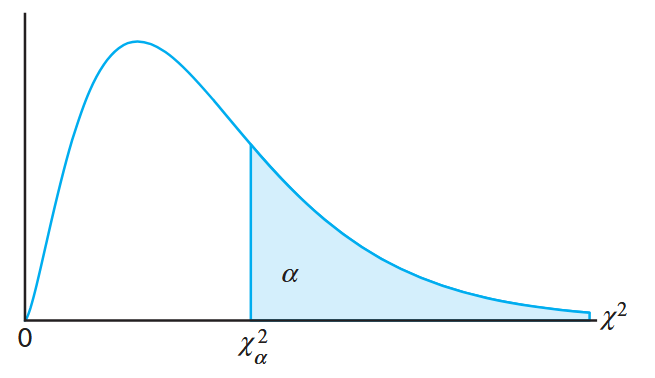
The chi-squared distribution. (Walpole et al., 2017).
There are tables that give values of
Exactly
Example:
A manufacturer of car batteries guarantees that the batteries will last, on average,
years with a standard deviation of year. If five of these batteries have lifetimes of , , , , and years, should the manufacturer still be convinced that the batteries have a standard deviation of year? Assume that the battery lifetime follows a normal distribution. Solution:
We first find the sample variance using the alternative formula:Then
is a value from a chi-squared distribution with
degrees of freedom. Since of the values with degrees of freedom fall between and , the computed value with is reasonable, and therefore the manufacturer has no reason to suspect that the standard deviation is other than year.
Degrees of Freedom as a Measure of Sample Information
It is known that
has a
has a
The reader can view the theorem as indicating that when
there is
In other words, there are
This concept of “losing” a degree of freedom when estimating parameters is fundamental to understanding why we use
t-Distribution
In The Central Limit Theorem, we discussed the utility of the Central Limit Theorem. Its applications revolve around inferences on a population mean or the difference between two population means. Use of the Central Limit Theorem and the normal distribution is certainly helpful in this context. However, it was assumed that the population standard deviation is known. This assumption may not be unreasonable in situations where the engineer is quite familiar with the system or process. However, in many experimental scenarios, knowledge of
since
In developing the sampling distribution of
where
has the standard normal distribution and
has a chi-squared distribution with
Theorem:
Let
be a standard normal random variable and a chi-squared random variable with degrees of freedom. If and are independent, then the distribution of the random variable , where is given by the density function
This is known as the t-distribution with
degrees of freedom.
From the foregoing and the theorem above we have the following corollary.
Corollary:
Let
be independent random variables that are all normal with mean and standard deviation . Let Then the random variable
has a t-distribution with
degrees of freedom.
The probability distribution of
What Does the t-Distribution Look Like?
The distribution of

The t-distribution curves for
and . (Walpole et al., 2017).
The percentage points of the t-distribution are usually given in a table.
It is customary to let
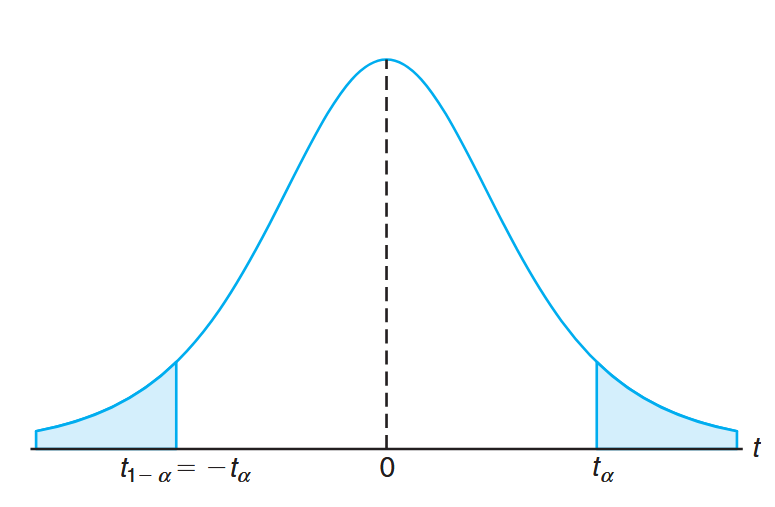
Symmetry property (about 0) of the t-distribution. (Walpole et al., 2017).
That is,
Example:
The t-value with
degrees of freedom that leaves an area of to the left, and therefore an area of to the right, is
Example:
Find
. Solution:
Sinceleaves an area of to the right, and leaves an area of to the left, we find a total area of between
and . Hence
Example:
Find
such that for a random sample of size selected from a normal distribution and .
Solution:
From a t-distribution table we note thatcorresponds to when . Therefore, . Since in the original probability statement is to the left of , let . Then, from the figure, we have Hence, from the table with
, and
Exactly
Example:
A chemical engineer claims that the population mean yield of a certain batch process is
grams per milliliter of raw material. To check this claim he samples batches each month. If the computed t-value falls between and , he is satisfied with this claim. What conclusion should he draw from a sample that has a mean grams per milliliter and a sample standard deviation grams? Assume the distribution of yields to be approximately normal. Solution:
From a table we find thatfor degrees of freedom. Therefore, the engineer can be satisfied with his claim if a sample of batches yields a t-value between and . If , then a value well above
. The probability of obtaining a t-value, with , equal to or greater than is approximately . If , the value of computed from the sample is more reasonable. Hence, the engineer is likely to conclude that the process produces a better product than he thought.
What Is the t-Distribution Used For?
The t-distribution is used extensively in problems that deal with inference about the population mean (as illustrated in the example above) or in problems that involve comparative samples (i.e., in cases where one is trying to determine if means from two samples are significantly different).
Important Notes:
- The use of the t-distribution for the statistic
requires that be normal. - The use of the t-distribution and the sample size consideration do not relate to the Central Limit Theorem.
- The use of the standard normal distribution rather than
for merely implies that is a sufficiently good estimator of in this case. - In chapters that follow, the t-distribution finds extensive usage.
F-Distribution
We have motivated the t-distribution in part by its application to problems in which there is comparative sampling (i.e., a comparison between two sample means). For example, some of our examples in future chapters will take a more formal approach: a chemical engineer collects data on two catalysts, a biologist collects data on two growth media, or a chemist gathers data on two methods of coating material to inhibit corrosion. While it is of interest to let sample information shed light on two population means, it is often the case that a comparison of variability is equally important, if not more so. The F-distribution finds enormous application in comparing sample variances. Applications of the F-distribution are found in problems involving two or more samples.
The statistic
where
Theorem:
Let
and be two independent random variables having chi-squared distributions with and degrees of freedom, respectively. Then the distribution of the random variable is given by the density function
This is known as the F-distribution with
and degrees of freedom (d.f.).
We will make considerable use of the random variable

Typical F-distributions. (Walpole et al., 2017).
Let
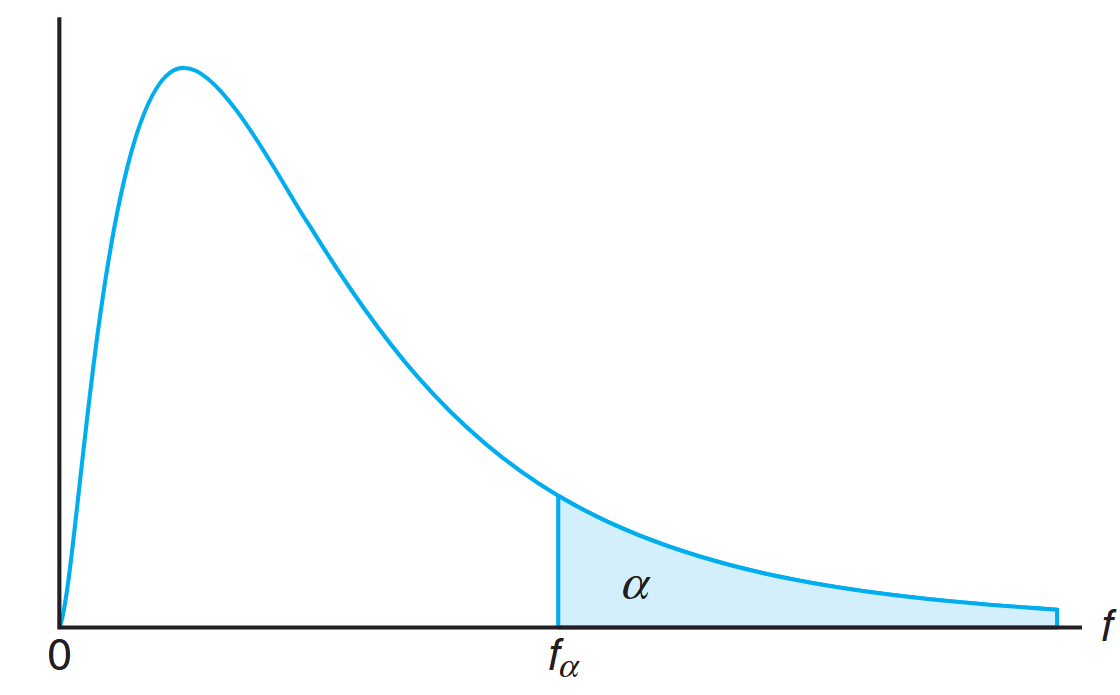
Illustration of the
for the F-distribution. (Walpole et al., 2017).
Tables give values of
Theorem:
Writing
for with and degrees of freedom, we obtain
Thus, the f-value with
The F-Distribution with Two Sample Variances
Suppose that random samples of size
are random variables having chi-squared distributions with
Theorem:
If
and are the variances of independent random samples of size and taken from normal populations with variances and , respectively, then has an F-distribution with
and degrees of freedom.
What Is the F-Distribution Used For?
We answered this question, in part, at the beginning of this section. The F-distribution is used in two-sample situations to draw inferences about the population variances. This involves the application of the theorem above. However, the F-distribution can also be applied to many other types of problems involving sample variances. In fact, the F-distribution is called the variance ratio distribution.
As an illustration, consider a case in which two paints,
| Paint | Sample Mean | Sample Variance | Sample Size |
|---|---|---|---|
The problem centers around whether or not the sample averages
The notion of the important components of variability is best seen through some simple graphics. Consider the plot of raw data from samples

Data from three distinct samples. (Walpole et al., 2017).
It appears evident that the data came from distributions with different population means, although there is some overlap between the samples. An analysis that involves all of the data would attempt to determine if the variability between the sample averages and the variability within the samples could have occurred jointly if in fact the populations have a common mean. Notice that the key to this analysis centers around the following two sources of variability:
Two Sources of Variability:
- Variability within samples (between observations in distinct samples)
- Variability between samples (between sample averages)
Clearly, if the variability in (1) is considerably larger than that in (2), there will be considerable overlap in the sample data, a signal that the data could all have come from a common distribution. An example is found in the data set shown in the following figure:

Data that easily could have come from the same population. (Walpole et al., 2017).
On the other hand, it is very unlikely that data from distributions with a common mean could have variability between sample averages that is considerably larger than the variability within samples.
The sources of variability in (1) and (2) above generate important ratios of sample variances, and ratios are used in conjunction with the F-distribution. The general procedure involved is called analysis of variance. It is interesting that in the paint example described here, we are dealing with inferences on three population means, but two sources of variability are used. We will not supply details here, but in future chapters we make extensive use of analysis of variance, and, of course, the F-distribution plays an important role.
Key Applications of F-Distribution:
- Comparing population variances from two or more samples
- Analysis of variance (ANOVA) procedures
- Testing equality of multiple population means
- Quality control and experimental design
- The F-distribution is also known as the variance ratio distribution

